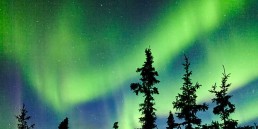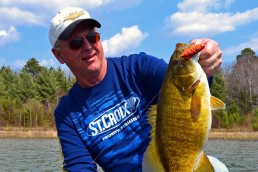Northern Lights: Enjoy the Show, but go Fishing Early
SHARE THIS POST
A showstopper it is, but the Northern Lights, or ‘Aurora borealis’ as it’s known, almost always has a big impact on fishing the next day.
The phenomenon is well understood in most respects, but is being researched continuously, so we don’t know everything about it. The dancing nighttime lights, which sometimes flow across the sky in awe-inspiring movement and colors, are caused by collisions between electrically-charged particles from the sun (where such collisions are common, given that surface temps are in millions of degrees) that escape through holes in the magnetic field and enter the earth’s atmosphere, carried on ‘solar winds.’
Displays are seen above the magnetic poles of both the northern and southern hemispheres, and are known as ‘Aurora australis’ in the southern hemisphere.
Pale green and pink are the most common colors seen, but shades of many other colors are sometimes present, and the shows can be spectacular, bringing summer vacationers out of their cabins to ooh and ah at them as if watching a fireworks display. “Local midnight” is known to be prime time to see the best of the ‘lights.’
Are you enjoying this post?
You can be among the first to get the latest info on where to go, what to use and how to use it!
Fun facts about Aurora:
• Most commonly, pale greenish colors are produced by oxygen molecules that ride about 60 miles above the earth.
• Rarely, you’ll see red Auroras created by high-altitude oxygen, as far as 200 miles up.
• Emissions from nitrogen molecules can produce blue or purplish Auroras, the most intense of all.
• Researchers discovered that ‘borealis’ and ‘australis’ are mirror-like displays of each other, that occur at the same time, with similar shapes and colors.
• The next big peak of Aurora activity is likely to occur in 2024. Research indicates peaks about every 11 years.
• Aboriginal people believed that aurora lights were the spirits of their ancestors.
• Sometimes––and this has been witnessed on several occasions by MidWest Outdoors editor Mark Strand in Ontario’s Sunset Country––you see multi-colored displays that pulse across the sky. They are a sight to behold.
Stay up and Watch, but Fish Early
You won’t find it in the literature, but anecdotal observations of what comes next prove true virtually every time: when you get a good Northern Lights show the night before, it gets rip-roarin’ windy the next day. So, as an angler, you should enjoy the show, go to sleep right after watching it, and get up early to fish. Because by midday, whitecaps on the water will rule the day and make boat control a pain in the butt.
Strand tells of hearing this from Ed Betts, owner of Whitefish Bay Camp when he was a youngster living on an island near the camp. “It’s gonna be windy tomorrow,” Betts said, as they were enjoying the Northern Lights. Sure enough, it was.
Sure enough, it’s been true virtually every time since, in our editor’s experience. Between “local midnight” and early morning is a brief few hours, so sleep fast and get out there. Fish hard early, and take a nap after a hearty shore lunch of fresh-caught fish.
MWO
SHARE THIS POST
Did you enjoy this post?
You can be among the first to get the latest info on where to go, what to use and how to use it!
Mark Strand
MidWest Outdoors editorial director Mark Strand is a graduate of University of Minnesota School of Journalism with a minor in Fisheries & Wildlife Science. He has written for nearly every outdoor magazine over the past 41 years, and has written or co-written 14 books. In addition to writing and photography, Strand produces the MidWest Outdoors Podcast, and contributes to MWO digital properties. He is an outdoor generalist who loves hunting and fishing of all types. In 2018 Strand was elected to the Minnesota Fishing Hall of Fame.



